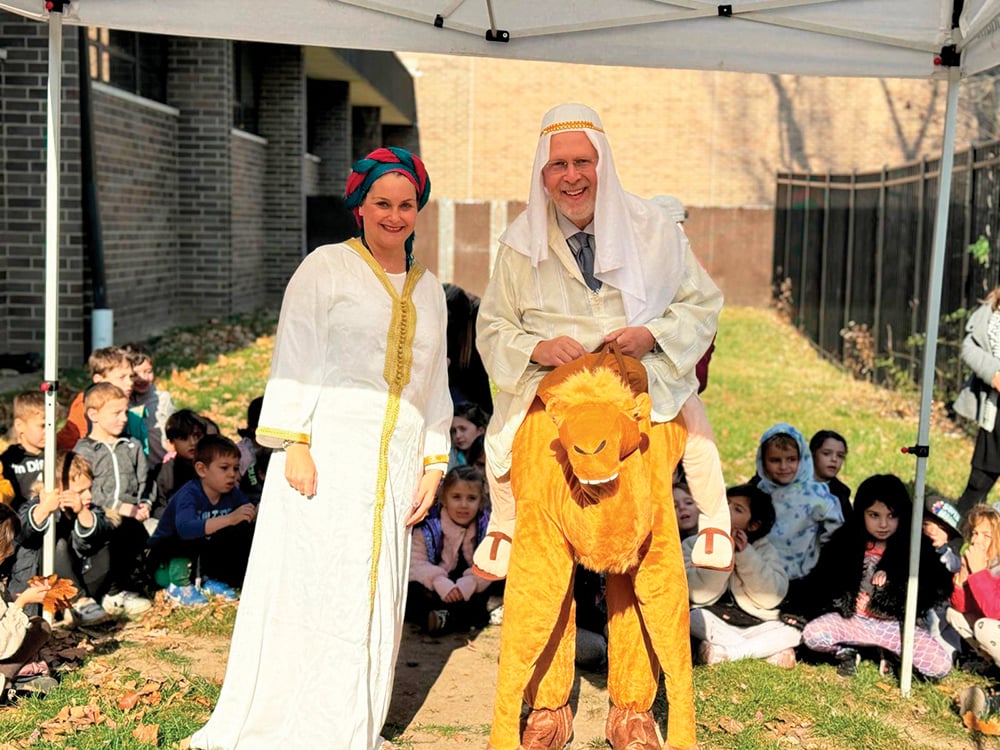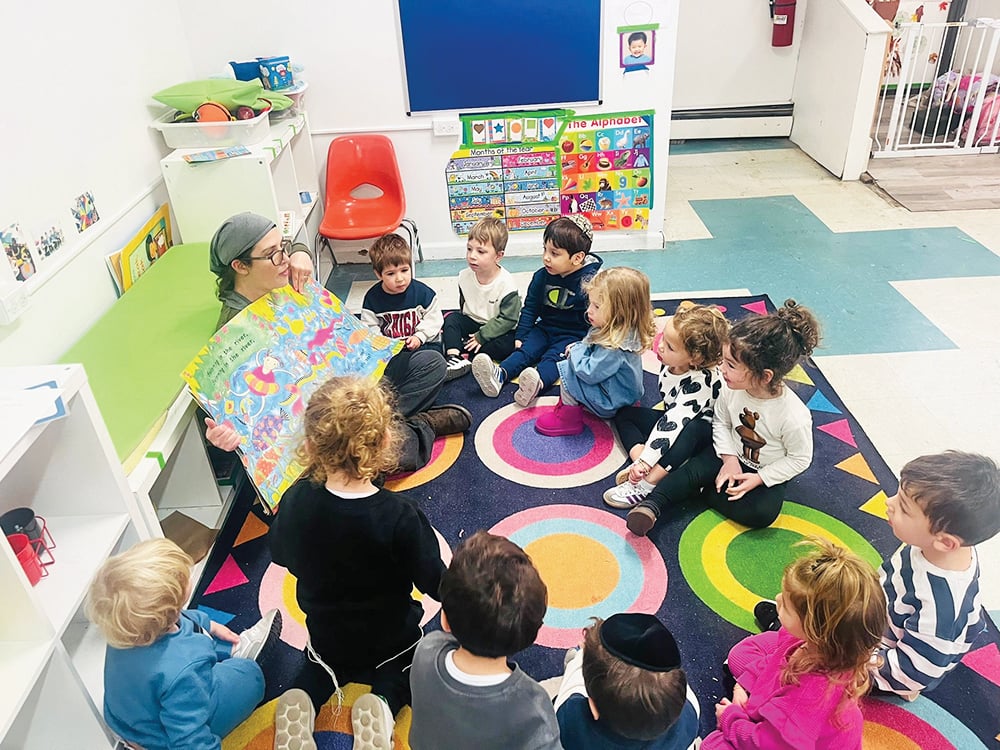
Bergenfield—The joy of Purim came a couple of weeks early this year, as crowd favorite Rabbi Meir Soloveichik, mara d’asra, but better known as ‘minister,’ of Congregation Shearith Israel of Manhattan and director of the Straus Center for Torah and Western Thought at Yeshiva University, recently came to Congregation Beth Abraham as a scholar-in-residence.
With immense mirth and energy, Rabbi Soloveichik, or ‘Solly Soloveichik,’ as he indicated he’s been known since elementary school, brought with him his unique brand of joie de vivre-inspired chinuch, a melange of Torah and history, religion and scientific analysis, peppering each talk with references as distant as the year 1290—the year the Jews were expelled from England—and as new as the age of Harry Potter. Salting the talks liberally with a diverse and wide breadth of knowledge, it all conveyed a genius-level command of Talmud, history and popular culture. The lightness of his touch made his Torah messages all the more effective.
Explaining to the congregation his recent move to Manhattan’s Upper West Side to head Congregation Shearith Israel, otherwise known as the Spanish and Portuguese Synagogue, Soloveichik proudly told the sizable crowd that he is the “tenth minister” of the congregation since the Revolutionary War. The oldest synagogue in America, the Spanish and Portuguese Synagogue has known congregants dating back to that era who are buried in the shul’s cemetery, including Jonas Phillips, a Jew who was a contemporary of George Washington.
Jonas Phillips was in fact the subject of Soloveichik’s first talk, ‘The Yiddish Letter and the Declaration.’ A Torah Jew in the difficult era of unrest in Colonial America, Phillips had the foresight to refer, in a letter to a Dutch business associate, to his new colonial home in Yiddish as a ganze medina (a whole country), in 1776, when America was little more than a “ragtag band” of 13 independent states.
It was more than ten years before the era of the Constitutional Convention, which began the organization of the colonies into the United States, the concept Phillips described, said Soloveichik. This and many other important historic papers relevant to the early Jewish history of America are stored in the archives of either his shul or in the New York Historical Society, which is housed nearby.
One of the key messages of the talk was that fidelity to Judaism was present in the public square during the formation of our country, as evidenced also by a subsequent letter Phillips wrote to George Washington and the members of the Constitutional Congress, seeking to participate in the legislature as a Jewish American, without having to take the Christian religious exam required for federal office holders.
A particularly entertaining aspect of Soloveichik’s talks was his continual tongue-in-cheek references to his new status as a Sephardic Jew given his placement in his just-adopted pulpit. Soloveichik’s lineage as part of the Brisk rabbinic dynasty is well known—he is a grandson of the late Rabbi Ahron Soloveichik and a great nephew of the late Rabbi Joseph B. Soloveitchik, known in YU circles as “The Rav.” (While the names are spelled differently, the families are the same).
The difference in practices between “us Sephardim,” and “you Ashkenazim” considerably impacted the life of a reigning British monarch, Soloveichik explained in his final talk. He was referring, of course, to “a shidduch gone terribly, terribly wrong,” otherwise known as ‘The Yibbum of Henry VIII.’ The lecture, a Soloveichik standard, essentially provided a crash course in British history in the age of the Tudor monarchy while also providing a strong understanding of the halakhic parameters of yibbum (levirate marriage), chalitza (levirate marriage’s ritual dissolution), the Jews of that era in Italy (the Jews had been expelled from England in 1290 by Edward I), and the role of the expulsion of the Jews from England in the creation of the Church of England.
Henry VIII’s major goal in seeking to dissolve his marriage—to his dead brother Prince Arthur’s wife Catherine of Aragon—was to try to have a legitimate male heir by marrying Anne Boleyn. His marriage to Catherine did not produce any surviving male children, and Anne Boleyn would not accept a status other than wife, so he tried to find evidence that his marriage was invalid by researching the Old Testament concept of levirate marriage. Differences between how the Ashkenazim and Sephardim practiced yibbum and chalitza impacted the course of the story, and therefore the course of British royal history.
In short, Henry VIII blamed his marriage to Catherine on his inability to produce a male heir, and sought to have it annulled or invalidated, arguing unsuccessfully to the Catholic Church that his marriage was unnatural and was essentially cursing his offspring. With many relationships with other women on record, he sought to ensure the continuity of his dynasty, but instead caused its extinction within one generation.
Soloveichik’s other two talks were as different as they were inspiring. In his Shabbos morning drasha, entitled ‘Shatnez at the Nobel Prize,’ he described Dr. Robert Aumann’s receipt of the award and the complications that arose due to Aumann’s Jewish observance. Since the tuxedos provided by the King of Sweden contained shatnez (a forbidden mixture of wool and linen), Aumann had to have tuxedos for himself and his 20-plus family members tailored in Israel, “Because, of course, the Israelis are well known for their intimate knowledge of formal wear,” Soloveichik joked.
Nonetheless, fidelity to Judaism and to the Jewish people, as in the lecture about Jonas Phillips, was evident in the Aumann lecture. The most rewarding moment of his visit to Sweden was, Aumann reported, seeing the Israeli flag fly over the Swedish royal palace.
The final talk was a purely Torah-based shiur called ‘Purim Drinking: A Less than Sober Reflection,’ that included commentary on the comparison of the words Yom Hakippurim and Purim. Rabbi Soloveichik stressed that there are two essential forms of wisdom: Wisdom of the heart and wisdom of the mind. Wisdom of the heart is emotional and represents our real inner longings. Wisdom of the mind, in contrast, is rational and utilitarian and often seeks to suppress our real desires.
What we do on Purim, when we are told to drink until we can no longer tell the difference between Mordechai and Haman, is drink until we turn off the wisdom of the mind and therefore allow a full manifestation our innermost longings for closeness to Hashem. Similarly, on Yom Kippur, we are doing tshuva (repentance) for all those instances where we allowed our utilitarian calculations to impede our spiritual progress.
With four spirited lectures over one Shabbos, with topics including both old world Jewish history and new world miracles, punctuated with strange and wonderful “only in New York,” stories involving hobbits in Central Park who know about Manhattan’s eruv, saleswomen in F.A.O. Schwartz who are fully versed in stuffed versions of animals that can be korbanos, the congregants of Beth Abraham in Bergenfield will not soon forget the inspiring and entertaining Torah of the Talmid Chacham called Solly.
By Elizabeth Kratz













